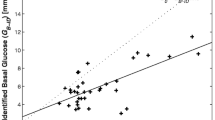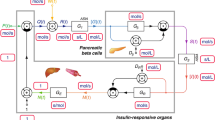Abstract
Several articles have investigated stochastic differential equations (SDEs) in PK/PD models, but few have quantitatively investigated the benefits to predictive performance of models based on real data. Estimation of first phase insulin secretion which reflects beta-cell function using models of the OGTT is a difficult problem in need of further investigation. The present work aimed at investigating the power of SDEs to predict the first phase insulin secretion (AIR 0–8) in the IVGTT based on parameters obtained from the minimal model of the OGTT, published by Breda et al. (Diabetes 50(1):150–158, 2001). In total 174 subjects underwent both an OGTT and a tolbutamide modified IVGTT. Estimation of parameters in the oral minimal model (OMM) was performed using the FOCE-method in NONMEM VI on insulin and C-peptide measurements. The suggested SDE models were based on a continuous AR(1) process, i.e. the Ornstein-Uhlenbeck process, and the extended Kalman filter was implemented in order to estimate the parameters of the models. Inclusion of the Ornstein-Uhlenbeck (OU) process caused improved description of the variation in the data as measured by the autocorrelation function (ACF) of one-step prediction errors. A main result was that application of SDE models improved the correlation between the individual first phase indexes obtained from OGTT and AIR 0–8 (r = 0.36 to r = 0.49 and r = 0.32 to r = 0.47 with C-peptide and insulin measurements, respectively). In addition to the increased correlation also the properties of the indexes obtained using the SDE models more correctly assessed the properties of the first phase indexes obtained from the IVGTT. In general it is concluded that the presented SDE approach not only caused autocorrelation of errors to decrease but also improved estimation of clinical measures obtained from the glucose tolerance tests. Since, the estimation time of extended models was not heavily increased compared to basic models, the applied method is concluded to have high relevance not only in theory but also in practice.


Similar content being viewed by others
References
Breda E, Cavaghan MK, Toffolo G, Polonsky KS, Cobelli C (2001) Oral glucose tolerance test minimal model indexes of beta-cell function and insulin sensitivity. Diabetes 50(1):150–158
Steil GM, Hwu CM, Janowski R, Hariri F, Jinagouda S, Darwin C, Tadros S, Rebrin K, Saad MF (2004) Evaluation of insulin sensitivity and beta-cell function indexes obtained from minimal model analysis of a meal tolerance test. Diabetes 53(5):1201–1207
Andersen KE, Hojbjerre M (2005) A population-based Bayesian approach to the minimal model of glucose and insulin homeostasis. Stat Med 24(15):2381–2400
Erichsen L, Agbaje OF, Luzio SD, Owens DR, Hovorka R (2004) Population and individual minimal modeling of the frequently sampled insulin-modified intravenous glucose tolerance test. Metab Clin Exp 53(10):1349–1354
De Gaetano A, Mingrone G, Castageneto M (1996) NONMEM improves group parameter estimation for the minimal model of glucose kinetics. Am J Physiol Endocrinol Metab 271(5):E932–E937
Sun H, Fadiran EO, Jones CD, Lesko L, Huang SM, Higgins K, Hu C, Machado S, Maldonado S, Williams R, Hossain M, Ette EI (1999) Population pharmacokinetics. A regulatory perspective. Clin Pharmacokinet 37(1):41–58
Madsen H (2007) Time series analysis. Chapman and Hall/CRC-Taylor and Francis Group, Boca Raton
Silber HE, Kjellsson MC, Karlsson MO (2009) The impact of misspecification of residual error or correlation structure on the type i error rate for covariate inclusion. J Pharmacokinet Pharmacodyn 36(1):81–99
Karlsson MO, Beal SL, Sheiner LB (1995) Three new residual error models for population PK/PD analyses. J Pharmacokinet Biopharm 23(6):651–672
Kristensen NR, Madsen H, Ingwersen SH (2005) Using stochastic differential equations for PK/PD model development. J Pharmacokinet Pharmacodyn 32(1):109–141
Overgaard RV, Jonsson N, Tornoe CW, Madsen H (2005) Non-linear mixed-effects models with stochastic differential equations: implementation of an estimation algorithm. J Pharmacokinet Pharmacodyn 32(1):85–107
Krishna R (2004) Applications of pharmacokinetic principles in drug development. Kluwer Academic/Plenum Publishers, New York
Tornøe CW, Jacobsen JL, Pedersen O, Hansen T, Madsen H (2004) Grey-box modelling of pharmacokinetic/pharmacodynamic systems. J Pharmacokinet Pharmacodyn 31(5):401–417
Picchini U, Ditlevsen S, Gaetano De A (2006) Modeling the euglycemic hyperinsulinemic clamp by stochastic differential equations. J Math Biol 53(5):771–796
Mortensen SB, Klim S, Dammann B, Kristensen NR, Madsen H, Overgaard RV (2007) A matlab framework for estimation of NLME models using stochastic differential equations: applications for estimation of insulin secretion rates. J Pharmacokinet Pharmacodyn 34(5):623–642
Klim S, Mortensen SB, Kristensen NR, Overgaard RV, Madsen H (2009) Population stochastic modelling (PSM)—an R package for mixed-effects models based on stochastic differential equations. Comput Methods Programs Biomed (in press, corrected proof)
Hovorka R, Chassin L, Luzio SD, Playle R, Owens DR (1998) Pancreatic beta-cell responsiveness during meal tolerance test: Model assessment in normal subjects and subjects with newly diagnosed noninsulin-dependent diabetes mellitus. J Clin Endocrinol Metab 83(3):744–750
Cretti A, Lehtovirta M, Bonora E, Brunato B, Zenti MG, Tosi F, Caputo M, Caruso B, Groop LC, Muggeo M, Bonadonna RC (2001) Assessment of beta-cell function during the oral glucose tolerance test by a minimal model of insulin secretion. Eur J Clin Invest 31(5):405–416
Breda E, Toffolo G, Polonsky KS, Cobelli C (2002) Insulin release in impaired glucose tolerance: oral minimal model predicts normal sensitivity to glucose but defective response times. Diabetes 51(suppl 1):S227–S233
Mari A, Tura A, Gastaldelli A, Ferrannini E (2002) Assessing insulin secretion by modeling in multiple-meal tests: role of potentiation. Diabetes 51(suppl 1):S221–S226
Mari A, Schmitz O, Gastaldelli A, Oestergaard T, Nyholm B, Ferrannini E (2002) Meal and oral glucose tests for assessment of beta-cell function: modeling analysis in normal subjects. Am J Physiol Endocrinol Metab 283(6):E1159–E1166
Overgaard RV, Jelic K, Karlsson M, Henriksen JE, Madsen H (2006) Mathematical beta cell model for insulin secretion following IVGTT and OGTT. Ann Biomed Eng 34(8):1343–1354
Brubaker PL, Ohayon EL, D’Alessandro LM, Norwich KH (2007) A mathematical model of the oral glucose tolerance test illustrating the effects of the incretins. Ann Biomed Eng 35(7):1286–1300
Hansen T, Drivsholm T, Urhammer SA, Palacios RT, Volund A, Borch-Johnsen K, Pedersen O (2007) The BIGTT test: a novel test for simultaneous measurement of pancreatic beta-cell function, insulin sensitivity, and glucose tolerance. Diabetes Care 30(2):257–262
American Diabetes Association (2004) Diagnosis and classification of diabetes mellitus. Diabetes Care 27(suppl 1):S5–S10
Van Cauter E, Mestrez F, Sturis J, Polonsky KS (1992) Estimation of insulin secretion rates from C-peptide levels: comparison of individual and standard kinetic parameters for C-peptide clearance. Diabetes 41(3):368–377
Tornøe CW, Overgaard RV, Agersøe H, Nielsen HA, Madsen H, Jonsson EN (2005) Stochastic differential equations in NONMEM: implementation, application, and comparison with ordinary differential equations. Pharm Res 22(8):1247–1258
DeFronzo RA, Tobin JD, Andres R (1979) Glucose clamp technique: a method for quantifying insulin secretion and resistance. Am J Physiol 237(3):E214–E223
Toffolo G, Grandi De F, Cobelli C (1995) Estimation of beta-cell sensitivity from intravenous glucose tolerance test C-peptide data. Knowledge of the kinetics avoids errors in modeling the secretion. Diabetes 44(7):845–854
Matthews DR, Hosker JP, Rudenski AS, Naylor BA, Treacher DF, Turner RC (1985) Homeostasis model assessment: insulin resistance and beta-cell function from fasting plasma glucose and insulin concentrations in man. Diabetologia 28(7):412–419
Author information
Authors and Affiliations
Corresponding author
Rights and permissions
About this article
Cite this article
Møller, J.B., Overgaard, R.V., Madsen, H. et al. Predictive performance for population models using stochastic differential equations applied on data from an oral glucose tolerance test. J Pharmacokinet Pharmacodyn 37, 85–98 (2010). https://doi.org/10.1007/s10928-009-9145-5
Received:
Accepted:
Published:
Issue Date:
DOI: https://doi.org/10.1007/s10928-009-9145-5




